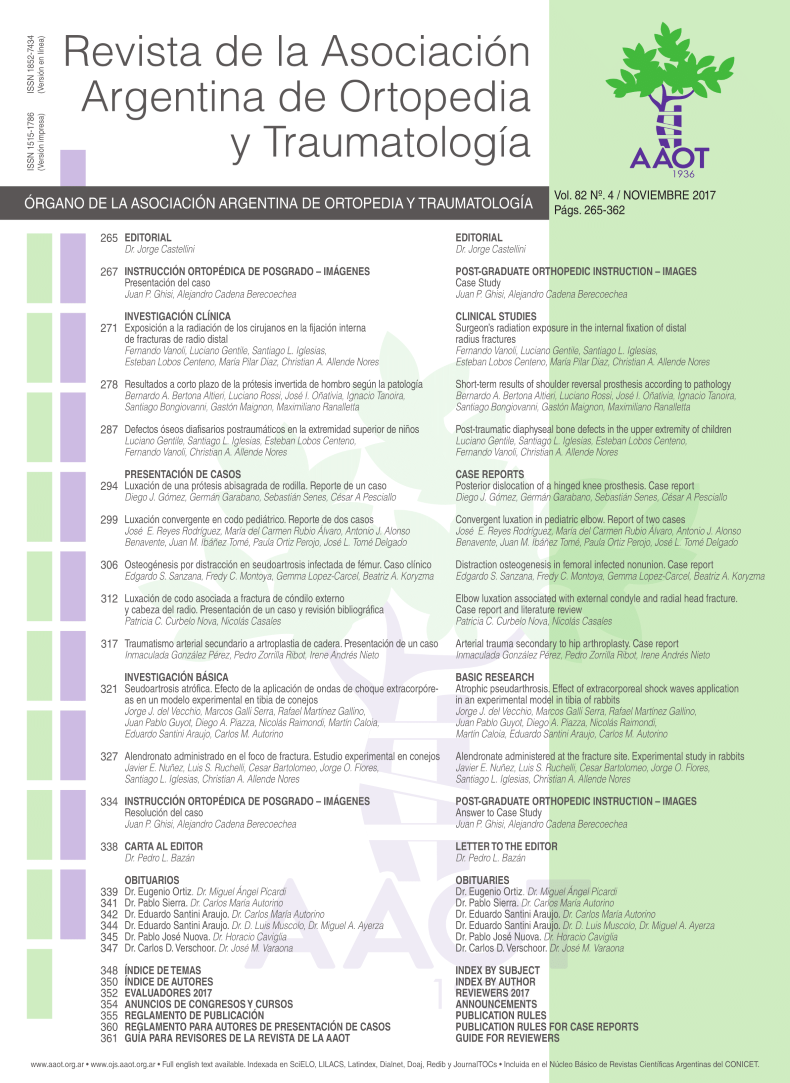Postraumatic diaphyseal bone defects in the upper extremity in children.
Main Article Content
Abstract
Downloads
Metrics
Article Details

This work is licensed under a Creative Commons Attribution-NonCommercial-ShareAlike 4.0 International License.
Manuscript acceptance by the Journal implies the simultaneous non-submission to any other journal or publishing house. The RAAOT is under the Licencia Creative Commnos Atribución-NoComercial-Compartir Obras Derivadas Igual 4.0 Internacional (CC-BY-NC.SA 4.0) (http://creativecommons.org/licences/by-nc-sa/4.0/deed.es). Articles can be shared, copied, distributed, modified, altered, transformed into a derivative work, executed and publicly communicated, provided a) the authors and the original publication (Journal, Publisher and URL) are mentioned, b) they are not used for commercial purposes, c) the same terms of the license are maintained.
In the event that the manuscript is approved for its next publication, the authors retain the copyright and will assign to the journal the rights of publication, edition, reproduction, distribution, exhibition and communication at a national and international level in the different databases. data, repositories and portals.
It is hereby stated that the mentioned manuscript has not been published and that it is not being printed in any other national or foreign journal.
The authors hereby accept the necessary modifications, suggested by the reviewers, in order to adapt the manuscript to the style and publication rules of this Journal.
References
2. Sales de Gauzy J, Fitoussi F, Jouve JL, Karger C, Badina A, Masquelet AC. Traumatic diaphyseal bone defects in children. Orthop Traumatol Surg Res. 2012; 98(2):220-6.
3. Ring D, Allende C, Jafarnia K, Allende BT, Jupiter JB. Ununited diaphyseal forearm fractures with segmental defects: plate fixation and autogenous cancellous bone-grafting. J Bone Joint Surg. 2004; 86: 2440-45.
4. Hope PG, Cole WG. Open fractures of the tibia in children. J Bone Joint Surg Br 1992;74—B:546—53.
5. Buckley SL, Smith G, Sponseller PD, Thompson JD, Griffin PP. Open fractures of the tibia in children. J Bone joint Surg Am 1990;72—A:1462—9.
6. Keating JF, Simpson AHRW, Robinson CM. The management of fractures with bone loss. J Bone Joint Surg Br 2005; 87-B: 142-150.
7. Liu HC, Hsu CC. Regeneration of a segmental bone defect after acute osteomyelitis due to an animal bite. Injury 2004;35:1316—8.
8. Sales de Gauzy J, Vidal H, Cahuzac JP. Primary shortening followed by callus distraction for the treatment of a post- traumatic bone defect. J Trauma 1993;34:461—3.
9. Rigal S, Merloz P, Le Nen D, Mathevon H, Masquelet AC. Bone transport techniques in posttraumatic bone defects. Orthop Traumatol Surg Res 2012; 98: 103-108.
10. Karger C, Kishi T, Schneider L, Fitoussi F, Masquelet AC. Treatment of posttraumatic bone defects by the induced membrane technique. Orthop Traumatol Surg Res 2012; 98: 97-102.
11. Allende C, Allende BT. Posttraumatic one-bone forearm reconstruction. A report of seven cases. J Bone Joint Surg. 2004; 86A: 364-9.
12. Papakostidis C, Bhandari M, Giannoudis PV. Distraction osteogenesis in the treatment of long bone defects of the lower limbs. Effectiveness, complications and clinical results; a systematic review and meta-analysis. Bone Joint J. 2013; 95B: 1673-80.
13. Nusbickel FR, Dell PC, McAndrew MP, Moore MM. Vascularized Autografts for Reconstruction of Skeletal Defects Following Lower Extremity Trauma. A Review. Clin Orthop Relat Res. 1989;243:65-70.
14. Masquelet AC, Begue T. The concept of induced membrane for reconstruction of long bone defects. Orthop Clin North Am 2010; 41: 27-37.
15. Allende C, Mangupli M, Bagliardelli J, Diaz P, Allende BT. Infected nonunions of long bones of the upper extremity: staged reconstruction using polymethylmethacrylate and bone graft impregnated with antibiotics. Chir Organi Mov 2009; 93: 137-142.
16. Hinsche A, Giannoudis PV, Matthews SE, Smith RM. Spontaneous healing of large femoral cortical bone defects: does genetic predisposition play a role?. Acta Orthop Belg 2003;69:441-446.
17. McKibbin B. The biology of fracture healing in long bones. J Bone Joint Surg 1978; 60-B: 150-162.
18. Keating JF, Simpson AHRW, Robinson CM. The management of fractures with bone loss. J Bone Joint Surg 2005; 87-B:m142-150.
19. Malizos KN, Papatheodorou LK. The healing potential of the periosteum molecular aspects. Injury 2005; 36: S13-9.

